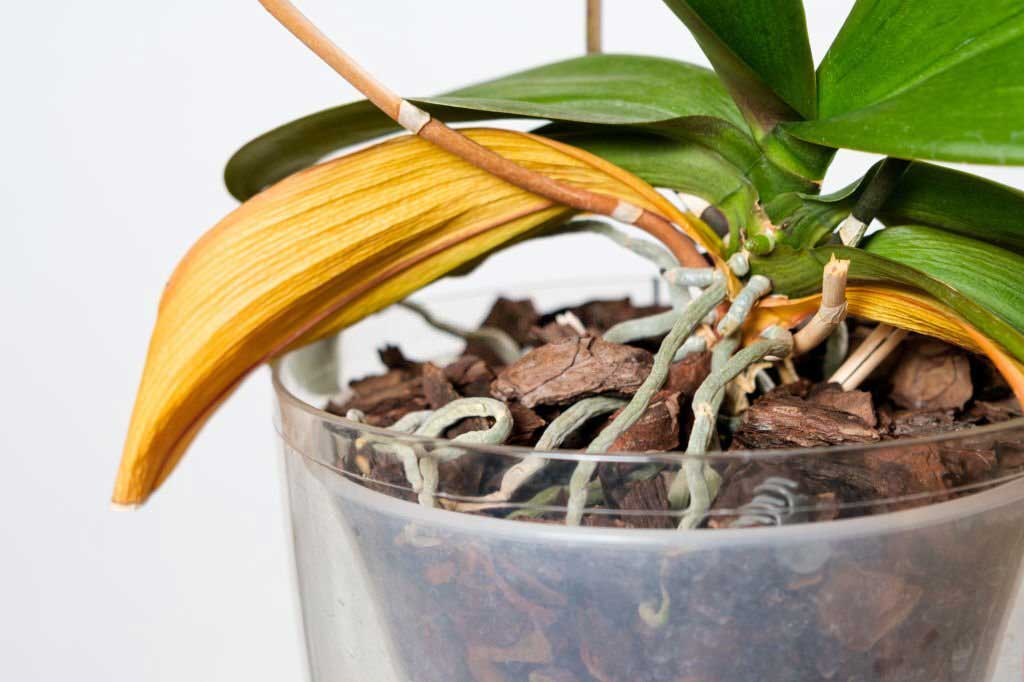
List of the most common causes
Orchid leaves can tell us many things about the health of the plant…the issue is understanding what they are trying to tell us! In this regard, one thing to be sure of is that if the leaves start to turn yellow, the orchid is not doing well.
We have tried to summarise in this article all the possible causes and some useful tips.
Old leaves
The most common reason is simply that the leaf has turned yellow due to the natural ageing of the plant. This phenomenon usually happens with one leaf at a time and typically it’s the lower ones. The yellowing will start from the contours of the leaf inwards.
It is a natural process and you have nothing to worry about!
Too much or not enough water
It often happens to accidentally give the plant too much water and this causes water stagnation in the pot. Symptoms of this problem are yellow, soft and wet leaves, black roots and dark spots on the plant.
The solution to this issue is to repot the plant into new bark, carefully removing the current one from the roots. The plant should become lush again in a substrate that is not too wet.
If, on the other hand, the leaves appear dry and shrivelled up, the problem is the opposite of the one previously explained. Soaking the plant for 20-30 minutes in water should solve the problem.
SOIL
The substrate may be unsuitable for orchids or old and lacking enough nutrients that the plant needs.
The orchid needs specific potting substrate like this because, as stated in the previous point, it does not react well to water stagnation.
Here again, the solution to yellowing leaves is a simple repotting.
Too much light
This change is the slowest so care must be taken, as the leaves will gradually turn yellow. They will first turn a light green and then a yellow-green.
Usually the leaves at the top of the plant are the most affected.
In this case, you may try to move the plant to a more sheltered place.
Wrong temperature
Orchids do not do well in the cold, so when temperatures drop below 13°C (55,4°F) the leaves may turn yellow with brown patches. These symptoms will appear over time, making it difficult to identify what the problem is. When temperatures drop, the plant needs less water and it is very common to create water stagnation in the pot.
Check your thermometers and keep your orchid warm.
Infections or pests
If the plant is covered with yellow and black spots but the flowers remain intact, it is unfortunately a fungal infection. We recommend treating the plant with a pesticide and repotting it.
In case the orchid has watery, foul-smelling spots or small lesions that enlarge and yellow with time, this is a bacterial infection. To treat the plant, cut off the infected part with sterilised scissors and apply hydrogen peroxide or antibiotics.
The best known pest is the mite or ‘red spider mite’. The leaves of orchids attacked by this parasite turn yellow or silver and show discolouration on the leaves. The solution is to wash the plant with warm water and spray it with insecticide.
Fertilizer
Lack of nutrients such as nitrogen can lead to yellowing of the leaves, but the plant will suffer more if you give too much fertiliser.
Too much fertiliser creates a build-up of nutrients in the soil that will prevent the plant from absorbing water, causing the leaves to dry out from the tip towards the plant.
The solution is to rinse the substrate so that the excess salts are washed away.


 Italiano
Italiano